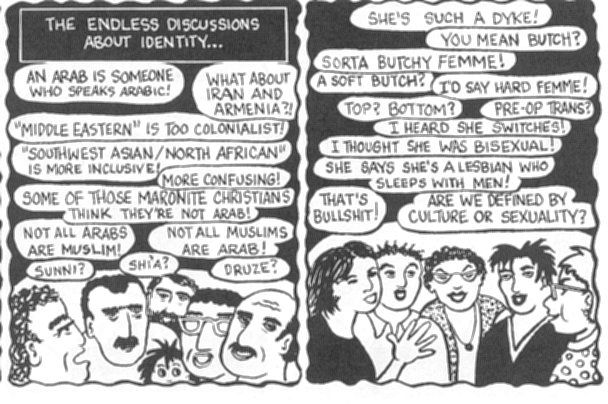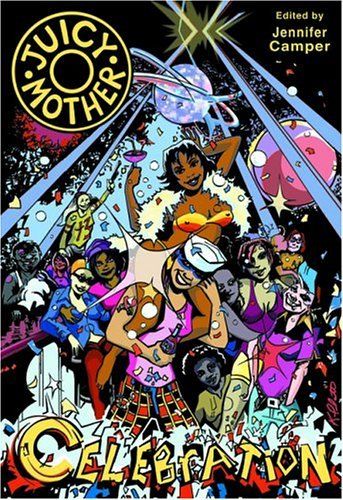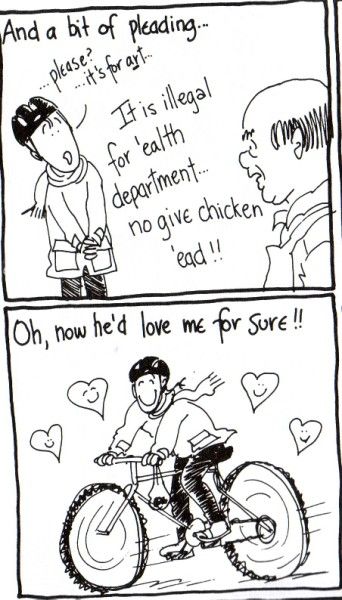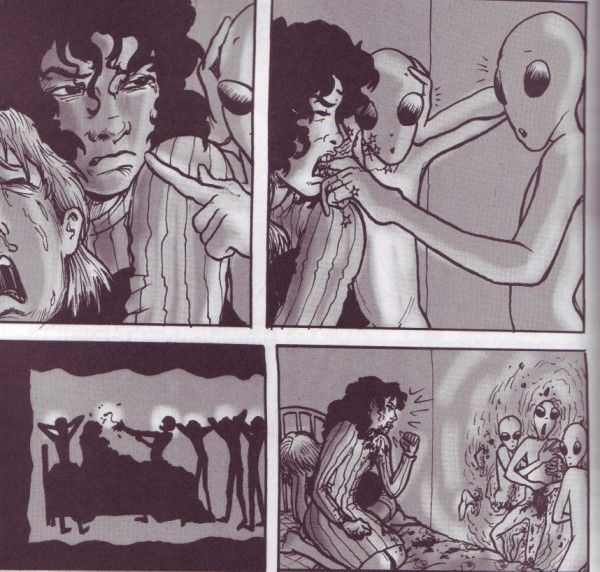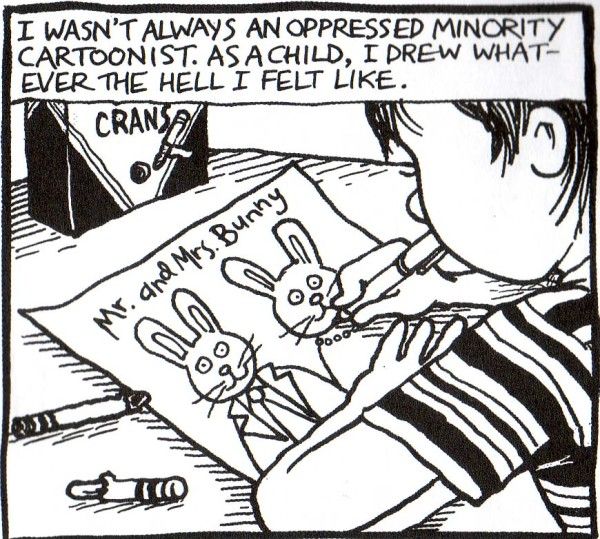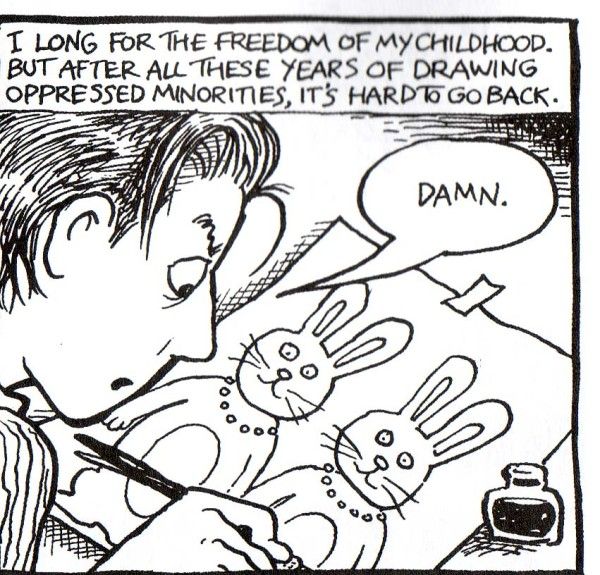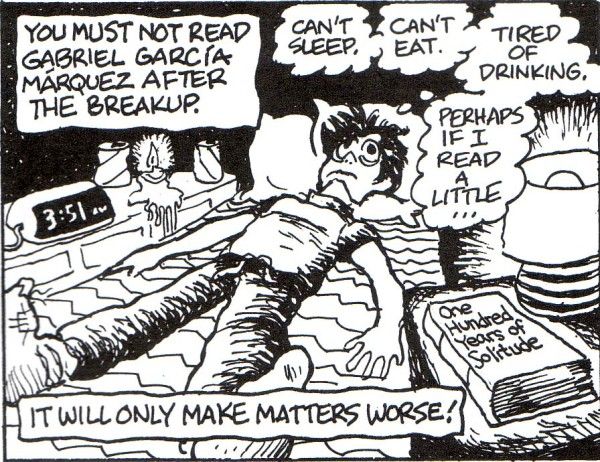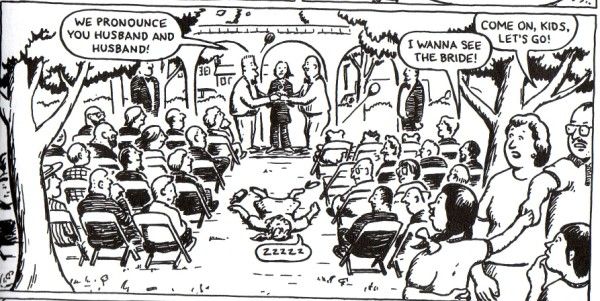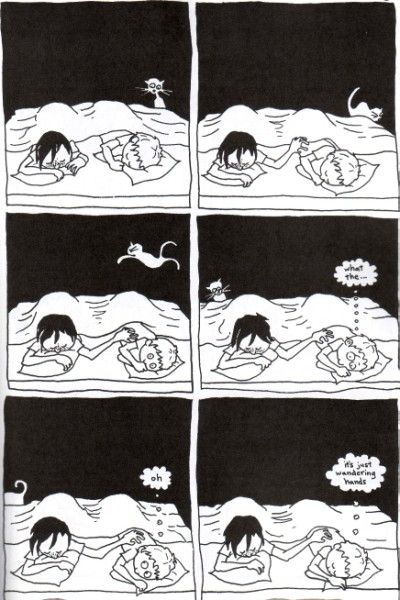Here's the part where the straight, white (American) male reviews the collection of mostly gay but sometimes other ethnic and racial minority comics. Let's see what happens.
Juicy Mother is an aught five anthology from Soft Skull press featuring work by a bunch of folks I've quite honestly never heard of, mixed in with stuff from some "indy big" names like Howard Cruise, Ariel Schrag and Alison Bechdel. All in all it's pretty good fun, and quite effectively celebratory to boot. It's tough for an anthology to maintain a specific vibe all the way through, but Juicy Mother pulls it off.
So. Recommended. But switch that too slightly recommended because of that one story in the middle.
I'm gonna spend a little over a thousand words quibbling with the one page introduction. But that's one page out of 96, and the introduction is not the actual art, and the actual art is the important thing, and the actual art is good.
Barring that one story in the middle.
I did have serious SERIOUS problems with the one page introduction written by editor Jennifer Camper that kicks the volume off. Serious enough problems that I'm actually going to go point by point and quote the introduction, tossing in little nuggets of actual review as I go, when I get bored or stop feelin' bitchy.
So. About that introduction. Take it away, editor Jennifer Camper...
Wors and pictures together are damn powerful. Whether you call them sequential art, cartoons, comics or comix, drawings combined with text create some amazing art.
MarkAndrew Sez:
HERE I agree, of course. Comics can make me happy in my soul. Especially comics that have panels like this, from Leanne Franson's Chicken Head Love.
Now I grantcha my definition of "Amazing" might not synch with the general population. But Franson's line-light and perfectly emotive cartooning was my favorite new discovery from this book. thing about this book. And, somehow, "Riding your bike through New York city to present the object of your affection with a chicken head they can use in art class, trying to disquise the smell of dead chicken blood on the subway, eventual rejection, and drowning one's sorrows in PURPLE RAIN" symbolically sums up my love life in ways I'm afraid to even TRY to explain. Glancing at her site, it seems that Franson seems to be mostly a comic book illustrator now-a-days, but I'd mos' def like to see more sequential art from her.
This was just great stuff. Probably the (purposefully) funniest rejection/break-up strip I've ever read.
In the United States, comics for grown-ups are published as "alternative comics" and graphic novels. The medium is slowly gaining more respect as an art form. Granted, the US trails Asia, Europe, and South America in this regard, and the economic prospects for most cartoonists are dismal. But, over time, there's been some small growth in opportunities for the creation of this kind of art - non-superhero, not-for-children, experimental, independent, and ground-breaking comics.
MarkAndrew sez:
Point the First: Defining alternative comics and graphic novels as "not for children" is applying a definition I'VE never heard, and I am scary comics nerd who lives 'n breathes this stuff. Not all adult material is "alternative," or non-corporate, like Garth Ennis' VERY adult themed Punisher MAX series.
And then there's this here. Great little kid's book. Published by "Alternative Comics."
I'm sure there is some fluidity to the term, but I generally here "alternative" meaning "Non corporate, creator owned." Certainly not specifically adult.
In fact, I really do believe that the capacity to produce genuine, all-ages material is one of comics-as-a-medium's greatest strengths. Works like the Arrival are going to mean different things to kiddy and adult audiences, but it's beautiful cartooning and subtle menace can certainly appeal to both.
Swinging back to Juicy Mother: There are a couple sexy and some violent strips I wouldn't feel comfortable sharing with kids, but several of the strips I'd feel fine reading with a bright twelve year old. Including Camper's own Ramadan.
Veering away from the "Celebration" subtitle, Ramadan is a kinda fiction based essay detailing an American lesbian of Arabic, Muslim descent observing the rituals of Ramadan. At least the no eating or sex before sundown aspects - There doesn't seem to be a lot of praying going on here. In an offbeat way, the strip becomes a subtle homage to Islamic perseverance, as we see Camper's hero accept the hunger pains and the confusion and scorn of her friends and acquaintances - even her lover informs her "Religion will drive you fucking crazy if you think about it to much" - because "[Ramadan] it reminds me of who I am." It's about finding balance, about how we relate to cultural traditions, and it's the kind of thing that kid's SHOULD be thinking about. (Which is An argument I've made before.) RAMADAN is a smartly empathic and surprisingly funny strip, incorporating information gained from actual interviews with Arabic Lesbians, to cleverly blur the fantasy/reality line.
Point the Second: South America? Really?
Point the third: "non-superhero, not for children, experimental, independent, and ground-breaking?" I'm not sure if Camper is lauding comics that posess all of these qualities, or books that possess any of them. But if the former is true, the categorization seems overly - and pointlessly - dismissive and if the latter than Camper's definition becomes so inclusive as to be nearly worthless. From my own POV "ground-breaking" is so much more important than the other arguments as to render 'em nearly moot...
And, not to pointlessly rehash this blog's phiolsophy, but GOOD trumps 'em all. I didn't enjoy Juicy Mother 'cause it's non-superhero or independent. I like it because I think it's well crafted, edited, and engaging.
And yet, something is missing. We all like to read comix relating to our own experiences of the world. Where are the comix for me, a Lebanese American dyke? Back in the day there were titles like Gay Commix, Wimmin's Comix, and Tits and Clits, but they're no longer published. Where are the comix by and about women, people of color and queers? I want an alternative to the alternative, but there are few venues for these stories.
OK. There are a couple of assumptions here that I agree with, one stated and one implied. And some stuff that leaves poor little straight, white me baffled.
Camper's overview of the comics scene seems fairly spot-on. American alternative comics creators do tend to skew male, and REALLY skew white. I recall, but can't find, a thread on our forum where we were trying to list black independent comic creators - and ended up with five or six names total. Hispanic and Asian-decended folks seem to work in American comics in equally small numbers. (There's the Bros. Hernandez, Derek Kirk Kim, Gene Yang.... Uh.... That's all I got.)
I'm less sure about gay creators. I can name only a handful, but I vaguely assume there are a decent number of homo guys 'n gals who's sexuality simply isn't communicated in their work.. But that's pure speculation on my part, and Camper may well know better than I do.
So I certainly believe that the the Lebanese Lesbian (hee hee) comics scene offers up some extremely slim pickings.
But here's another fact about straight, white me.. I've recently enjoyed the duck out of comics about growing up in Malaysia, the Ivory Coast, or Japan. And my all time favorite comics feature Spider-man, an elementary school-girl from the trailer park, a mostly invisible living cartoon devil cat who may or may not be the reincarnated Judas Iscariot, and Tales of the Beanworld... Which is, surprisingly, exactly what it sounds like.
Here's ANOTHER strength of the comics medium for out list: They have an arms-spread-wide acceptance of Fantasy-oriented material. While in literature, Kurt Vonnegut has to fight not to be stuck in the science fiction ghetto, the comics canon doesn't seem to discriminate between quoteunquote real quoteunquote literature and fantastic stories.
And what does fantasy do? It says "Imagine yourself in a situation that is NOT like your real life."
So... maybe, just maybe... Fantasy teaches empathy. ? !
And, to just briefly brush over this extemely common MarkAndrew talking point, the best fantasy is grounded in metaphor, metaphor serves to universalize, so I wouldn't be TOO surprised if there are some gay Lebanese women out there who are perfectly happy reading Batman, like the majority of comics fan. And that Batman DOES relate to their experiences with the world, and that it IS for them. Because, let's face it, it is a little tough for any of us to DIRECTLY relate running around in long-eared jammies and fighting evil clowns to our day to day lives.
In fact, one of the strongest stories in the book, Laritza versus the Space Invaders by Ivan Velez Junior starts out as a true-to-life story of a tentative friendship between high school girls and ends with
I'm not trying to use this story to prove my greater thematic point, but I am saying: Sometimes, if you have a good story and then you bring in some goddamn aliens, your good story can turn frickin' awesome. This darkly eerie but ultimately triumphant comic is another of the book's high points.
And it proves that NOT seeing our life experiences reflected back at us can be a hell of a lot of fun.
I'm not trying to completely dismiss Camper's point here. I can buy that there is a general set of experiences more or less unique to gay people, Asian people, Native American people, or disabled people. Even *gasp* children. (Which doesn't mean I'm not gonna rip on high school kids later in this essay.) And I cheerfully buy the PC trope that a medium that reflects a diversity of points of view is a healthy medium. But Camper's not making a diversity of viewpoint argument.
I'm sure it's more an important aspect of her day to day life than my straight white male-ness, which doesn't leave me feeling discriminated against, out of place, or socially questionable... There's an awareness of being in a minority group that I simply don't have. I GET that. But, sure, labels like "Eskimo" or "bi" can deliniate a specific social experience, they don't capture the whole of a person. Camper seems to be saying that, as a "Lesbian American Dyke" she can ONLY relate to "Gay Comix" and "Tits and Clits."
Which is odd, especially when you're talking comics, which are all about tearing down the line between audience and Superman.
Strangely, one of the strips deals with some of the same issues. Allison Bechdel's What I Know About Being an Oppressed Minority Cartoonist talked about moving from
to
And gives a dryly satirical and surprisingly thorough two page run-down of the psychological and sociological barriers that create a polarizing tension between being a MINORITY cartoonist and a JES' PLAIN cartoonist. While Camper's introduction offers overly pat summations, WIKABAOMC is about working through mixed feelings, and, paradoxically, comes out sounding more truthful than Camper's introduction because of it.
And so Juicy Mother was Born. Here is a home for the stories for the rest of us. Here are comix for Discerning Homosexuals, Uppity Ladies, Fierce People of Color and all their friends.
MarkAndrew:
I'll forgo the linguistic quibbling here, except to note that if I was a non-discerning homosexual or an un-fierce person of color, I'd be pissed.
Contrary to the last paragraph, here I'm finding Camper position overly inclusive. The social experience of being gay is not the social experience of being a person of color. Heck, the social experience of being black is not the same as being Asian.
What DO all these groups have in common? What defines the Oppressed Minority? My gut reaction is that Camper is grouping women, gays, and people of color by shared victim-hood, like that's the MOST IMPORTANT aspect of their culture. And that seems at least potentially insulting.
And, I mean, I DID like the book. And I think Camper does a fine job as editor. But I suspect her professed motions for the creation of the book. "Hey, here's a bunch of cartoonists I like!" Fine. "This is a personal work, relating to three aspects of my existence: A gay, female, person of color." Good, good. "I want to demonstrate the range and diversity of viewpoints in comics." Great, great. Here's a book of comics by gay people, people of color, and women. Because gay people, people of color, and women are somewhat indistinguishable and NEED to have their experiences reflected back at them? Questionable.
This is doubly questionable because the work in the book is really gay. Or at least 13 of the sixteen stories prominently feature gay characters. And two of those were written by creators who are openly gay. Wouldn't it have been easier to call Juicy Mother a platform for gay cartoonists instead of the all-out inclusiveness that the book tries and fails to demonstrate?
Or maybe it's worth this inclusiveness JUST for Laritza versus the Space Aliens.
And just 'cause a cartoonist is working from a gay perspective doesn't mean they can't comment on universal experiences.
Joan Hilty's piece demonstrates what happens if you do the wrong thing after "the break-up."
And, while Robert Triptow's Teddy Bear's Wedding confused me a bit on the first read-through, I finally figured it out, and it's dealing with another fairly fundamental truth.
Teddy Bear's Wedding is set on "June 1999... Back in the days when "gay marriage" was still only make believe." It begins with an announcement celebrating the union of Carlo Crapo and Von Van Von. It ends with two announcements proclaiming the "undying love" Carlo Crapo and Von Van Von have.... for two OTHER guys, and the caption "If at first you don' succeed, try and try again."
Essentially, Triptow presents a series of sight gags, verbal gags, and a page of paper dolls demonstrating that gay marriage can be as silly, ostentatious, and disaster-prone as ANY marriage, anywhere.
Huh. Pause. One thing I've noticed as I read these stories is that they DO feel happy and celebratory, a lot of 'em deal with emotional disasters, break-ups, and heartbreak. Neat trick.
Dianne Dimassa's Must Be Love follows the cycle of urban love and loss around a circle of urban friends, Stephen Winter and Robert Kirby's Dollface takes a half-smilng look at getting older, and the end of the issue cartoon jam (Which never coheres into any sort of story. But it's fun to play "spot the artist") ends with everybody arrested, or dead, or rendered fictional.
And there's the part in the middle
I didn't like it. Hated it, in fact. And having to talk about it is gonna shoot my carefully constructed review all to hell.
The story is cartooned by Serena Pillai, and it's called the Italian Cousin. I didn't like how it was drawn. I didn't like how it was written. I didn't like how it was translated from it's original Italian; At least I hope to Jesus the word "whore" was not the original intent of the text in the second to last panel. And, oh yeah, I especially didn't like the part where the heroine of the piece has sex with her fifteen year old cousin.
I guess it's slightly mollified by the fact that the fifteen year old cousin comes on to the twenty year old babysitter. But then again, not really. I'm generally fine with ambiguous endings, but I'm gonna go out on a limb here and say that fucking your fifteen year old cousin is a bad idea a conservative 99.9999 times out of a hundred, and it would be nice if the story indicates this.
So, to review: The Italian Cousin is poorly constructed on every level, EXTREMELY morally questionable, and not only bad enough to single-handedly cost the whole anthology half a "recommended" grade, but so terrible it totally messes up the structure of my review.
Thanks a fucking lot, Serena Pillai.
So JUST to make myself feel better, I'm gonna end with a page from Ariel Schrag's Wandering Hands.
I had trouble understanding the story, and I've had problems with Schrag's earlier work. Her four part 240 page POTENTIAL was spectacularly good for having been written in high school, or, by an objective standard, kind of terrible.
But I really liked her short pieces in STUCK IN THE MIDDLE. And, to throw objectivity to the winds, I think I enjoy looking at her work on a visceral, directly-wired-into-my-pleasure center sense more than any other cartoonist's. Look at that kitty in panel three! So cool!
So without The Italian Cousin I'd give this book a strong thumbs up. And I suppose that, despite being the longest story in the book it's still skipable it won't knock the whole work down a grade. And while I do wish Camper had put more thought into using her introduction to properly frame and define the content of this anthology, it doesn't seem fair to hold the text piece she obviously tossed off in fifteen minutes against the rest of the book. I'm looking forward to reading the next in the series.

